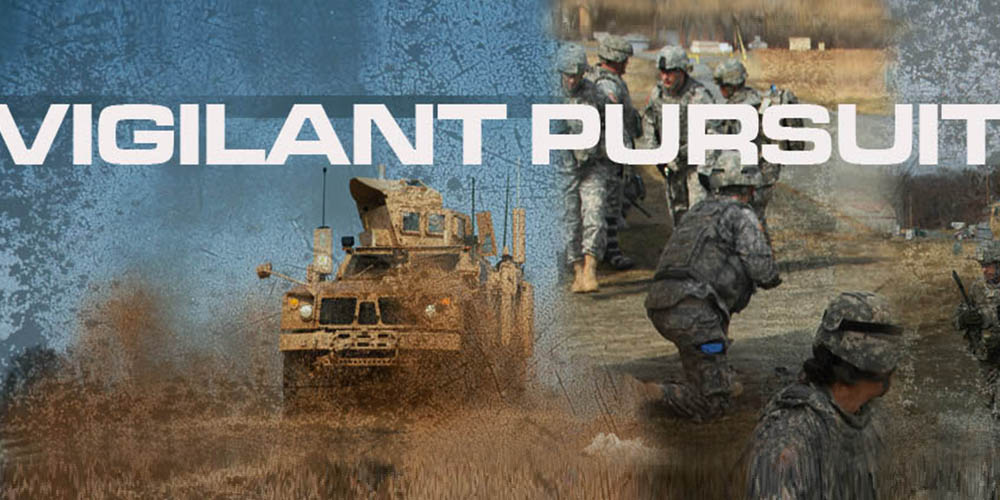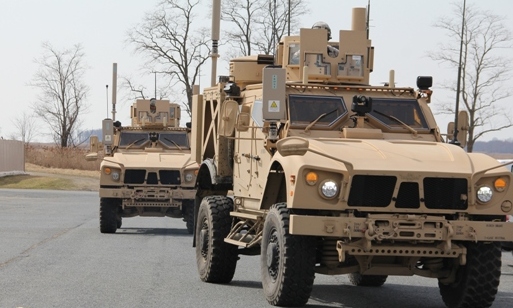
By Kristen Kushiyama, RDECOM CERDEC Public Affairs
ABERDEEN PROVING GROUND, Md. (January 26, 2015) – U.S. Army researchers have improved training for Soldiers on a quick-reaction intelligence capability to better support the system in the field and potentially reduce reliance on reach-back and in-field contractor support.
NCOs from the U.S. Army Research, Development and Engineering Command’s Communications-Electronics Center (RDECOM CERDEC) have expanded the training that Soldiers receive on Vigilant Pursuit, a multi-intelligence system designed to reduce the time it takes to properly identify and take down a high-value target.
Vigilant Pursuit combines human intelligence and signals intelligence capabilities, or respectively, HUMINT and SIGINT, to provide Soldiers with information to identify persons of interest while on a mission. HUMINT comes from information collected by Soldiers on people, while SIGINT is gathered by intercepting electronic signals. The system uses cross-cueing and tipping—two ways of passing along information without human intervention—to enable Soldiers to make decisions that require time-sensitive responses.
“I’m a fan of this technology to find bad guys using one of these tools,” said Lt. Col. Scott Fitzgerald, 109th Military Intelligence Battalion Commander out of Joint Base Lewis-McCord, Washington. “Vigilant Pursuit is user-friendly and there was a lot of good training on the equipment,” he said, adding that the trainers, who had been recently deployed, provided a lot of knowledge.
Because Vigilant Pursuit is a quick-reaction capability developed by CERDEC’s Intelligence and Information Warfare Directorate (I2WD) for the U.S. Army G-2, Office of the Deputy Chief of Staff for Intelligence, and not a program of record, operating and maintenance skills for the system are not taught in an Army schoolhouse. It’s I2WD’s responsibility to train Soldiers on the system, said Sgt. 1st Class Tavaris Burke, CERDEC I2WD.
Vigilant Pursuit operators include HUMINT and SIGINT collectors, analysts, linguists and maintainers. For training purposes, these specialties are broken into two broader categories—operators and maintainers. Operators’ functions vary and can range from linguists to signal analysts, while maintainers must have the knowledge necessary to fix computer circuit boards and electronics for military intelligence systems like Vigilant Pursuit.
Training for maintainers and operators has expanded since training on Vigilant Pursuit’s new equipment began in February 2012. Now, maintainers receive 15 days of training instead of eight. From the beginning, SIGINT and HUMINT operators were trained side by side to learn more about the information the other is seeking.
Now, maintainer participation has been added to the operators’ portion of the system training. Before 2014, the eight-day maintainer training did not leave ample time for the maintainers to cover enough of the hardware and software issues one might encounter while in the field, said Burke.

Vigilant Pursuit provides dedicated tactical pursuit vehicle-mounted and dismounted assets that utilize cutting-edge technologies, enabling SIGINT and HUMINT Soldiers to cross-tip and cross-cue timely intelligence so they can more rapidly and accurately identify high-value targets. (Photos courtesy of RDECOM CERDEC)
I2WD gets a first-hand look
In 2012 and 2013, Burke deployed to get a first-hand look at how the systems in the field were operated, employed and maintained. He wanted to see “how this system actually worked,” he said, “so I deployed to Afghanistan. While I was there, I worked with them [Soldiers, government civilians and support contractors] at the source. A lot of Soldiers weren’t having hardware issues; they were having software issues,” he added.
The consistent feedback and exchanges emphasized the need for additional software training for maintainers, said Burke. What could have been a simple, quick fix became more cumbersome because the Soldiers were not as familiar with the software as the result of the shortened maintainer training class. With a little more training, Soldiers could address these issues themselves and reduce reliance on field support representatives.
I2WD personnel and contractors were available beyond the allotted training hours to provide additional support and training if a Soldier had more questions or wanted to focus on a particular element of the system, Burke said.
Operators and maintainers require different training when using the system, said Staff Sgt. Jose George, I2WD. “Operators and maintainers are trained in two separate classes focused on their respective disciplines. It is more beneficial to have the maintainers come to I2WD first to receive maintenance training where they can get into the trucks and work the systems,” he said.
Once the maintainers learn the system and how to maintain it, they are on standby and participate at operator training to assist with hardware and software problems, thereby making them better equipped when the unit is in the field.
“As we are teaching operators, the maintainers are already there and they are already trained, so if operators need assistance, their own maintainer from their own battalion team can help out with the system,” George explained. “The maintainers get more experience from both training classes. We try to use the same maintainer who came to Aberdeen Proving Ground for training and over there in theater, so they can help out and build on the knowledge they just learned.”
Changing the training
I2WD also changed the way it trained operators on the Vigilant Pursuit system. Training is sometimes limited because of Army deployment requirements. One of the operator training sessions was kept to 10 days even though there were more than six weeks’ worth of material to teach operators, said George.
Soldiers can address a large portion of the six-week training by completing prerequisite courses before Vigilant Pursuit training, where they receive more hands-on training.
The 2014 courses followed a practice of cross-training between the various operators in the Vigilant Pursuit vehicles—within policy limits, which specify who can and cannot work in certain areas of a system for reasons ranging from training requirements to “need to know” requirements. This cross-training was originally identified in the first Vigilant Pursuit operator training class in 2012 by a unit that also received training in early 2014. The unit took the initiative to cross-train themselves, and I2WD observed the benefits and integrated this concept into the program, said Adam Bogner, chief of the I2WD Quick Reaction Capability Branch.

Vigilant Pursuit combines HUMINT and SIGINT capabilities to provide Soldiers with information to identify persons of interest while on a mission. Since 2012, training on the system has increased, providing Soldiers with more in-depth knowledge of how the system operates.
Being able to recognize the information that might be useful to the other Soldiers on the team is helpful for the entire team in executing their mission, George said.
“For example, a SIGINT-er will get some basic HUMINT training on their tools—like how they work, how they operate—because as a SIGINT sensors operator, he might see something that could be good information for the HUMINT operators on the team,” George said.
At the end of 2014, the Vigilant Pursuit team trained more than 80 soldiers on Vigilant Pursuit dismounted tools at the 525th Battlefield Surveillance Brigade Culminating Training Exercise in Camp Bullis, Texas. The initial training was in preparation for new equipment training conducted in November. From Nov. 3-14, the Vigilant Pursuit training team conducted training for system maintainers at Fort Bragg, North Carolina. Those maintainers then demonstrated what they learned by supporting operator training from Nov. 17-Dec. 5, further reinforcing practical skills on the system.
Bogner said his team expanded the 2014 training by adding a real-world signal simulator that can recreate a signal environment to enhance the training experience. That has allowed them to create multiple training scenarios for the operators to demonstrate their proficiency in operating the Vigilant Pursuit system effectively.
“This allows the trainers to easily change the scenarios to challenge the students continually, thereby enhancing the course and giving the students the ability to use the system as they will when deployed,” Bogner said.
I2WD will continue to enhance and update training on Vigilant Pursuit by adding additional elements, including the use of role players capable of speaking other languages to expand linguists’ training. The team is also looking to reduce the student-to-instructor ratio to ensure each Soldier receives sufficient hands-on training, said Courtney Bennett, CERDEC I2WD SIGINT Quick Reaction Capability Branch.
Additional training will also include expanded cross-training, which has been very beneficial for the multi-function teams and improves with each training iteration, Bennett said.
With deployments slowing down, Fitzgerald said he would like to see Military Intelligence Soldiers get more engaged with brigade combat teams and get certified on Vigilant Pursuit in order to expand its use at Combat Training Centers, including the Joint Readiness Training Center and National Training Center.

Subscribe to Access AL&T is the premier online news source for the Acquisition, Logistics, and Technology (AL&T) Workforce.
![]() Subscribe
Subscribe







